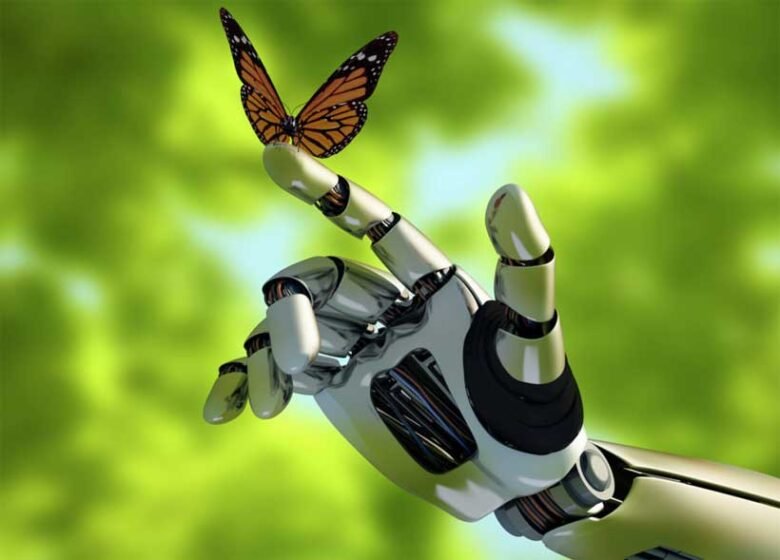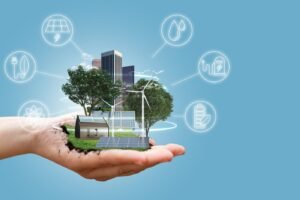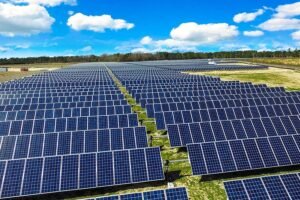The world is experiencing an unprecedented environmental crisis. The natural world is under enormous pressure. From deforestation, pollution, and climate change to loss of biodiversity and deforestation, it’s all there. Artificial intelligence (AI) is one of the best tools to combat these growing problems. Artificial intelligence (AI), which is the ability of machines and systems to perform tasks that would normally require human intelligence to complete, could revolutionize the way we monitor, protect, and understand the environment. AI plays a major role in sustainability initiatives by analyzing large amounts of data, predicting future trends, and optimizing the use of resources. AI, as technology advances, is becoming a key ally for creating a greener and cleaner future.
Improving Energy Efficiency with AI
The largest contributor to greenhouse gas emission is energy consumption. Artificial intelligence enhances energy systems by streamlining the production and distribution of energy. AI-powered smart grids can predict demand for energy in real time and adjust supply accordingly. This reduces waste and ensures stability. AI algorithms are also able to improve the efficiency and output of renewable energies like solar and wind power by predicting weather and adjusting operation for maximum output. AI-driven automation in manufacturing helps reduce energy usage by identifying inefficiencies within production processes. AI-driven lighting, heating, and cooling systems in offices and homes can save energy and maintain comfort. AI will play an increasingly important role as the world moves toward clean energy.
AI in Waste Management and Recycling
Waste management and recycling are also important applications of artificial intelligence. Every year, the world produces millions of tons of waste. Much of this waste ends up in landfills and pollutes oceans. AI-powered systems are able to help resolve this problem by improving how waste is collected, sorted, and recycled. Robotics and machine vision are used to separate recyclable materials with more accuracy than humans. AI sensors are used in some recycling facilities to distinguish between plastics, metals, and paper. This improves recovery rates and reduces contamination. AI can also be used to track waste generation patterns and help cities create smarter routes for waste collection and reduce emissions. AI can help create more sustainable and efficient waste management systems. It also promotes a circular economic model where materials are reused rather than thrown away.
AI for Biodiversity and Wildlife Protection
The health of our planet depends on biodiversity, but habitat destruction, poaching, and climate change are threatening it. AI plays a growing part in protecting and monitoring wildlife. AI uses image recognition and acoustic monitoring to identify animal species and track their movement. It can also detect illegal activities such as deforestation or poaching. Conservationists use drones with AI cameras for monitoring forests, oceans, and savannas. Such monitoring is done without disrupting ecosystems. AI systems are able to analyze underwater sounds in marine environments to detect whale activity and identify illegal fishing activities. These technologies enable scientists to collect valuable information on animal populations and to take action quickly to protect endangered species. Combining AI and conservation efforts will help us better understand ecosystems, and we can ensure that countless species survive for future generations.
AI and Pollution Control
Pollution affects air, water, and soil quality. Artificial intelligence (AI) is used to monitor levels of pollution and develop solutions for reducing them. AI systems connect smart sensors to detect pollution in real time, providing authorities with timely data to respond to contamination events. AI, for example, can analyze data collected from air quality sensors in cities to predict pollution spikes and improve traffic management and emissions control. AI algorithms are used in industrial sectors to monitor production processes and identify any leaks or inefficiencies that cause pollution. AI also helps clean up water by tracking the spread and optimization of wastewater treatment. AI helps industries and governments take proactive measures to create cleaner environments by identifying pollution sources and suggesting appropriate corrective actions.
AI and Water Resource Management
Water scarcity is a significant issue in many regions around the world. It is important to manage this precious resource effectively. AI is used to monitor the quality of water, predict demand, and detect leaks within distribution systems. Smart sensors linked to AI platforms are able to analyze water consumption patterns and provide suggestions on how to reduce waste. AI systems in agriculture optimize irrigation schedules using soil moisture data, weather forecasts, and other factors to ensure water is being used efficiently. AI is used in ocean research to track marine pollution, forecast algal blooms, and study the effect of climate change on sea level. AI’s innovations are helping to improve water management and preserve this resource for future generations.
Ethics and Challenges
AI is a powerful tool for protecting the environment, but it can also be a challenge. AI systems are developed and operated with significant computing power. These machines can use large amounts of electricity. Concerns are increasing regarding the sustainability of AI. Data privacy, accessibility, and the possibility of unequal distributions of technology benefits are all ethical concerns. AI should complement, not replace, human expertise. It is important to balance technological advancement with ethical and environmental responsibility to create solutions that are effective and fair. By addressing these issues, we can utilize AI to its fullest potential.
Conclusion
Artificial intelligence is changing the way that we protect our environment. AI helps humanity to tackle the world’s most pressing ecological issues. From managing waste and protecting animals to monitoring climate change and improving efficiency in energy use, AI can help. Because of its ability to analyze large amounts of data and offer actionable insights, AI is a powerful tool in the fight for sustainability. To fully utilize its potential, AI must be developed and utilized responsibly with an emphasis on minimizing the impact it has on the environment. AI will be more and more integrated into global efforts to restore the balance of our planet as technology advances. Human intelligence and artificial intelligence will work together to create a cleaner and greener environment in the future.
FAQs
1. How can AI help combat climate change?
AI can help fight climate change through analyzing environmental data and predicting extreme weather, optimizing energy systems, or supporting the transition to alternative energy sources.
2. Can AI reduce pollution?
AI can be used to monitor pollution, identify contamination sources, and optimize industrial processes to reduce harmful waste and emissions.
3. How does AI help wildlife conservation?
Image recognition, drone surveillance, and acoustic monitors are used to track animal populations, detect illegal poaching and deforestation, and use AI in wildlife protection.
4. Does AI in itself have an environmental impact?
AI is a powerful tool, but its computing processes are energy-intensive. Green data centers and energy-efficient algorithms are making AI more sustainable.
5. What role will AI play in the future of environmental protection?
AI’s future in protecting the environment lies in a deeper integration of renewable energy, sustainable farming, water management, and global climate monitoring.




